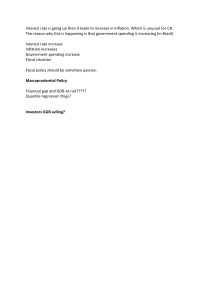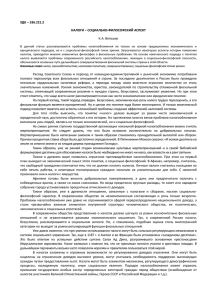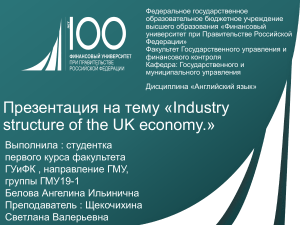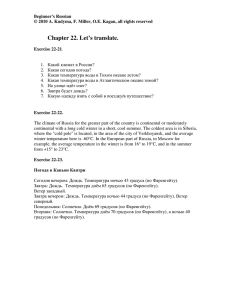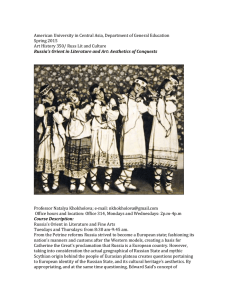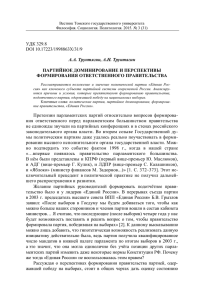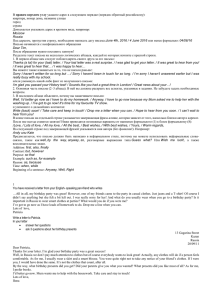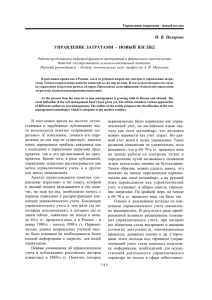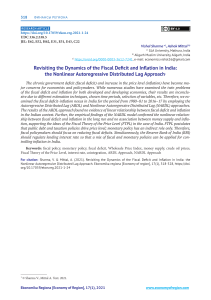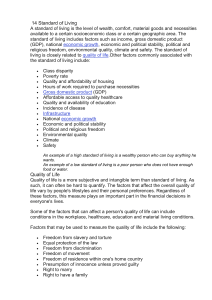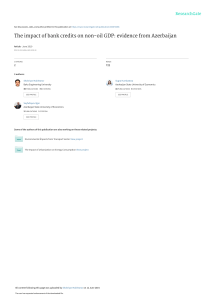Source - World Bank
реклама
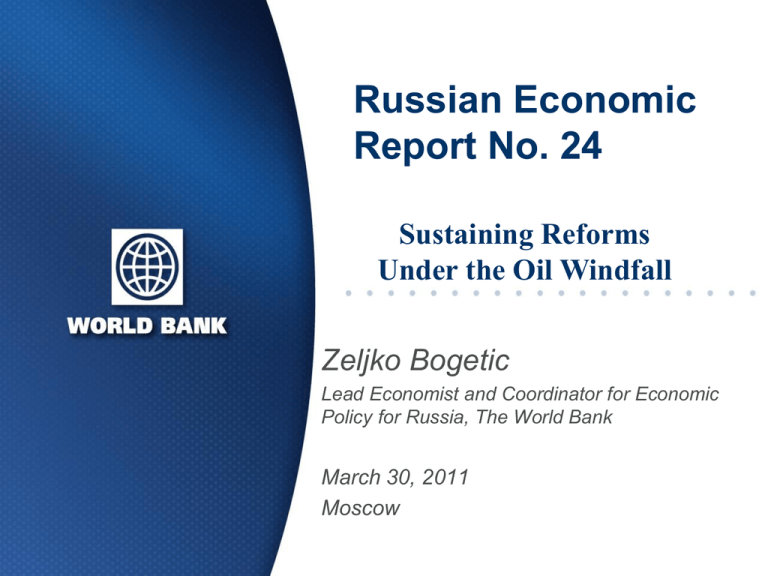
Russian Economic Report No. 24 Sustaining Reforms Under the Oil Windfall Zeljko Bogetic Lead Economist and Coordinator for Economic Policy for Russia, The World Bank March 30, 2011 Moscow OUTLINE I. Recent Economic Developments and Policies II. Russia’s Outlook for 2011-2012 III. Policy Challenges Global Environment Global risks increased – Slowdown after the 2010 bounceback – The new oil shock—oil above $100 pb – Aftereffects of the earthquake in Japan But the underlying growth of the global economy remains solid. Despite some deceleration, growth in developing countries remains robust Global Industrial production 20 10 EAP ECA MNA 0 SAS SSA LAC -10 -20 Source: Global prospects, World Bank. Instability in the Middle East may be affecting capital flows and risk perceptions Capital flows to developing countries $ b illion 2009 Jan Total H1 2011 2010 H2 Total 24 110 243 353 Jan H1 H2 Dec Total 38 197 316 Jan 42 512 41 Bonds 9 36 80 115 22 86 98 4 184 29 Banks 9 43 86 129 9 54 87 15 141 2 Equity 6 32 77 0 109 7 57 131 23 188 10 37 100 137 9 66 98 10 164 17 5 15 47 62 8 37 45 3 82 14 4 22 50 72 13 53 70 4 123 10 2 13 20 33 7 31 33 1 64 9 9 44 78 122 13 64 133 27 197 11 2 6 10 16 7 13 15 1 28 4 1 7 15 22 2 14 15 1 28 3 Lat. America Bonds E. Europe* Bonds Asia Bonds Others 10 * Including Poland & Croatia Source: DECPG Source: Global prospects, World Bank. RUSSIA’S RECENT ECONOMIC DEVELOPMENTS AND MACRO POLICIES IN 2010 • Economic growth (4%)--driven by inventory restocking and exports • Labor markets and poverty––gradually improving • Balance of payments––stronger because of high oil prices • Monetary policy–– inflation concerns • Fiscal policy––return of the “oil curse?” Russia’s economy grew 4.0 percent in 2010, driven largely by a sharp rebound in investment demand and growth in tradable industries GDP growth by main sectors (value added): 2006–2010 2007 2008 2009 2010 GDP growth 8.5 5.2 −7.8 4.0 Tradable sector 3.5 −0.1 −8.6 6.5 Agriculture, forestry 1.3 6.4 1.4 −12.1 Extraction industries −2.2 1.0 −0.3 4.8 Manufacturing 7.5 −2.1 −15.6 13.4 12.8 9.1 −7.0 2.9 −3.4 0.7 −3.0 5.9 Construction 13.0 11.1 −14.6 -0.9 Wholesale and retail trade 11.7 9.9 −6.5 4.5 Transport and communication 4.8 5.2 −8.4 7.0 Financial services 29.1 13.5 2.2 −3.0 Nontradable sector Electricity, gas, and water production and distribution Source: World Bank staff calculations based on Rosstat data. Labor markets – gradually improving with limited effect of seasonal unemployment Labor productivity, disposable income, wages, and unemployment 2007 2008 2009 2010 Jan– Dec Jan– Dec Jan– Dec Jan–Dec GDP growth (%, y-o-y) 8.5 5.2 −7.8 4.0 Total employment (million people) 70.5 70.9 69.4 69.6 Employment growth (%, y-o-y) 2.4 0.5 −2.1 0.3 Labor productivity growth (%, y-o-y) Real disposable income growth (%, y-o-y) 6.0 4.7 −5.9 3.7 12.1 1.9 1.9 4.1 Real wage growth (%, y-o-y) 17.2 11.5 −2.8 4.2 Average monthly wage (US$) 533.2 692.1 593.0 697.8 6.1 7.8 8.2 7.2 Unemploymentb (%, end of period) a Source: Rosstat. Data for the first half of 2010. Russia’s poverty rates have been broadly flat in 2009 and continued to fall in 2010 Poverty rates Millions of people 21.7 15.2 13.3 13.4 13.2 18.9 12.7 11.2 19.0 18.7 18.0 15.9 10.0 2006 2007 2008 2009 2010 2011 2012 14.1 2006 2007 2008 2009 2010 2011 2012 Balance of payments––stronger because of high oil prices Balance of payments (USD billions), 2007–2010 2010a Q32010a Q42010a 2007 2008 2009 77.0 103.7 49.4 72.6 6.1 14.3 130.9 155.4 111.6 149.2 29.1 34.3 84.8 −131.3 −44.3 −30.5 −6.0 −21.4 −12.9 −11.3 −1.7 −5.4 2.7 −1.5 148.9 −38.9 3.4 36.8 2.8 −8.6 Current account balance Trade balance Capital and financial account Errors and omissions Change in increase) reserves (+ = Source: CBR. a Preliminary estimates. Monetary and exchange rate policy • Inflation concerns result in CBR tightening monetary conditions • The exchange rate management complicated by a possible return of speculative capital inflows with high oil prices • gradual credit recovery under way • CBR has further widened the exchange rate corridor Stock of credits to companies and households in 2007–10 16,000 14,000 12,000 10,000 8,000 6,000 4,000 Dec-06 Feb-07 Apr-07 Jun-07 Aug-07 Oct-07 Dec-07 Feb-08 Apr-08 Jun-08 Aug-08 Oct-08 Dec-08 Feb-09 Apr-09 Jun-09 Aug-09 Oct-09 Dec-09 Feb-10 Apr-10 Jun-10 Aug-10 Oct-10 Dec-10 2,000 Credits to non-financial organizations, bln rubles Credits to households, bln rubles Source: CBR; World Bank staff estimates. Increases in food prices contributed to inflation in June 2010-Feb 2011 period Food Inflation, by components: June 7, 2010 - March 7, 2011 104 Contribution of each food component to 2.3 percentage points hypothetical increase in poverty Meat 21% Other Cereals 23% 23 25 20 11 11 18 19 Food inflation, 17.5 2 -1 3 9 Fish 0% Dairy 11% Tea Buckwheat 9% 0% Salt 0% Sweets 3% Potatoes 11% Eggs 3% Apples 9% Veggies 7% Oils & Fats 3% Fiscal policy––return of the “oil curse?” Medium term fiscal framework (in percent of GDP) Revenues (Consolidated) Of which Federal budget Expenditures (Consolidated) Of which Federal budget Federal budget Non-oil deficit Federal budget balance Consolidated budget balance 2011* 2012* 2013* 34,8 34,0 33,2 17,6 17,0 16,8 38,9 37,6 36,3 21,1 20,1 19,7 -11,6 -10,5 -9,8 -3,5 -3,1 -2,9 -4,2 -3,6 -3,1 *Draft Budget 2011 – 2013. Source: World Bank staff estimates based on draft budget documents, the Ministry of Finance. Strengthening Aggregate fiscal discipline • The government expects in the medium term to gradually reduce the fiscal deficit from budgeted 4.1 percent of GDP in 2010 to 2.9 percent in 2013 • This is a reasonable plan, but the budget remains vulnerable to new expenditure pressures. And non-oil fiscal deficit will decline only gradually • A more ambitious fiscal adjustment might be needed to strengthen Russia’s budget’s capacity to deal with new shocks--reduce non-oil fiscal deficit faster to the long-term sustainable level • Both revenue and expenditure measures will be needed 14 Measures to implement a more ambitious fiscal adjustment – Further broadening the non-oil tax base (e.g., increasing excises on tobacco, alcohol, vehicle licenses; revisiting VAT exemptions and some mineral extraction tax preferences). – Strengthening results monitoring systems to monitor target indicators of public programs. – Continue strengthening public expenditure management and controls – Reducing non-priority and unproductive expenditures e.g., crisis-related subsidies supporting select sectors of the economy. – Increasing the targeting of social assistance programs. – Taking steps to ensure the long-term sustainability of the pension system – Supporting structural reforms in the education and health sectors. – Implementing systematic annual public expenditure reviews to improve effectiveness of public expenditures Russia’s non-oil fiscal deficit under alternative adjustment scenarios (in percent of GDP) Global Environment for Russia, 2011-2012 (real GDP growth, %) 2009 (actual) 2010 (actual) 2011 2012 −2.2 3.9 3.1 3.4 −3.4 2.8 2.4 2.7 2.0 7.0 6.0 6.1 −7.9 4.0 4.4 4.0 World High-income countries Developing countries Russian Federation Source: Global Prospects for world growth; Russian Economic Report for Russia, The World Bank. The beginning of 2011 brought about a new global oil supply shock World Bank oil price forecast. Average crude (Brent, Dubai and WTI), simple average, $/bbl 96.80 96.99 92.3 90 79.00 70 61.76 50 2008 2009 2010 Source: World Bank Staff 2011 2012 Outlook for Russia: 2010 - 2012 2011 2012 4.4 4.0 −0.9 −0.8 Current account (US$ billions) 67 28 Capital account (US$ billions) 13 19 GDP growth (%) Consolidated government balance (% of GDP) Source: Russian Economic Report, The World Bank. Demand Sources of Russia’s Growth Demand sources of Russia’s real growth, by quarter, 2008–10 (percent change year to year) 15 10 5 0 9.10 7.70 5.20 6.40 3.10 5.50 4.50 4.50 2.70 3.40 4.30 -1.10 -2.90 -5 -10 -9.30 -8.60 -11.00 Net Exports Investment Consumption Growth -15 -20 Source: Rosstat; World Bank staff estimates. In Sum … Solid growth, the new oil windfall: - Solid growth (4% in 2010), accelerating to 4.4% in 2011 - Lower than expected unemployment (7.6%) and poverty (12.7%) - Higher export and fiscal revenues Policy initiatives: - Progress on WTO - Privatization - Effectiveness of public expenditures Concerns: - Fiscal policy risk rising—potentially escalating expenditures during political cycle - Delays in structural reforms Policy challenges Reducing inflation Implementing medium-term fiscal adjustment towards sustainable non-oil fiscal deficit (4.3% of GDP). Improving the efficiency of public expenditure to create fiscal space for productive infrastructure Strengthening the investment climate for the private sector remain among key long-term challenges. Strengthening skills and institutions Thank you!
